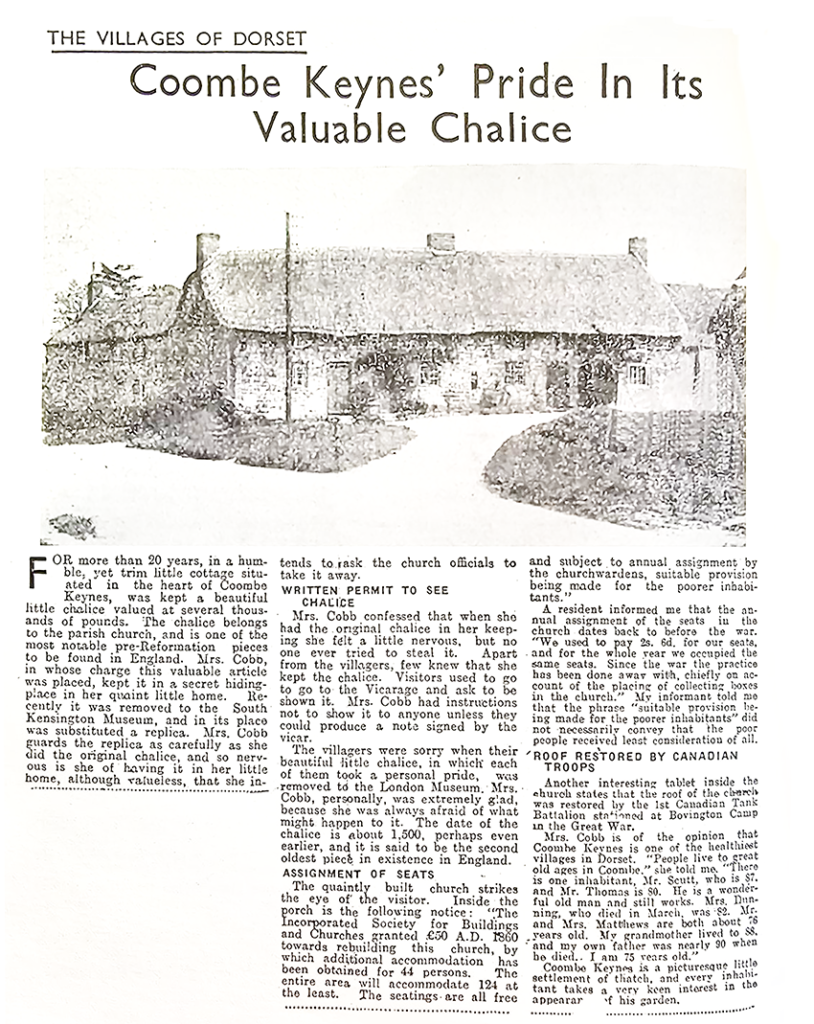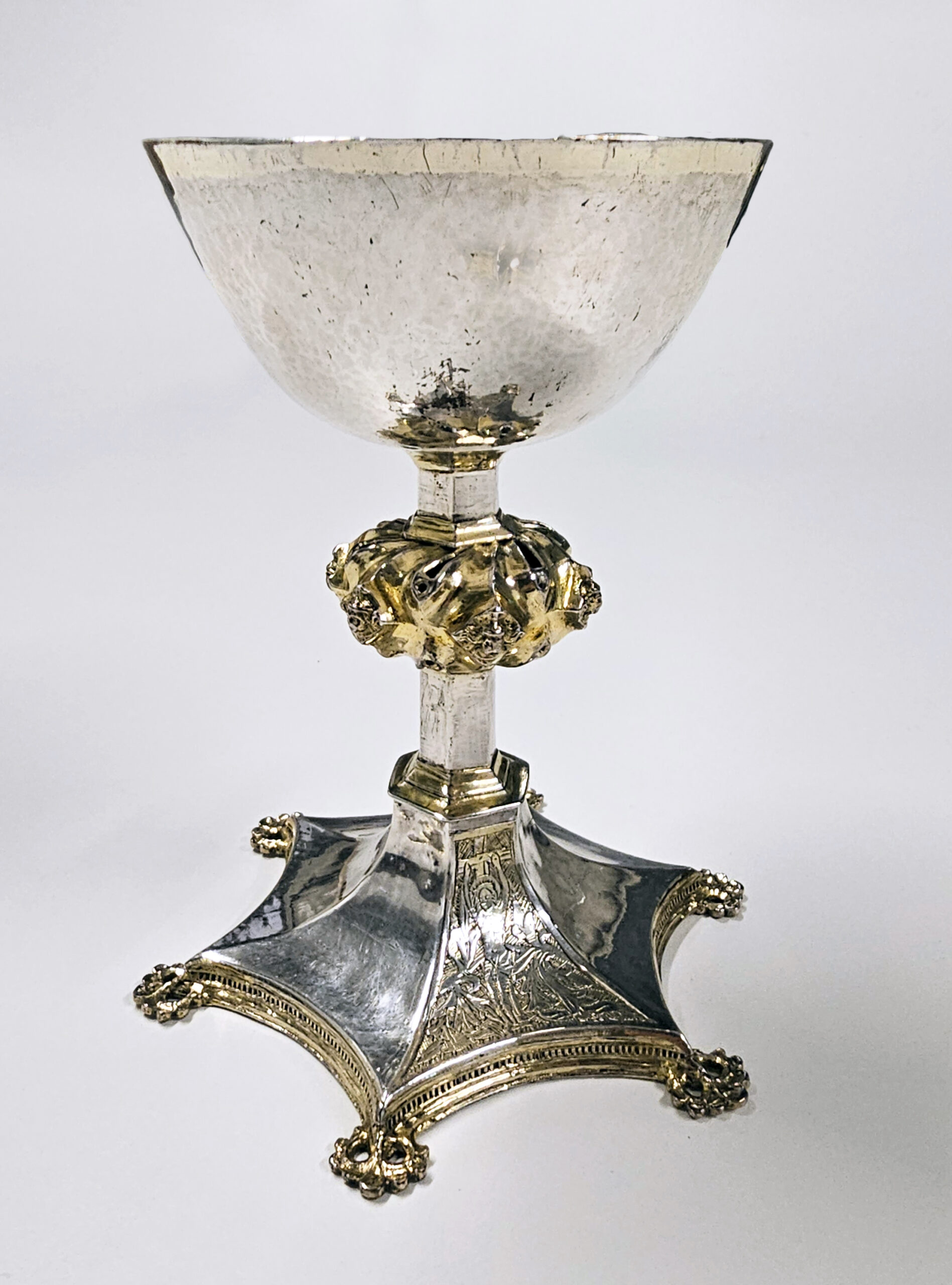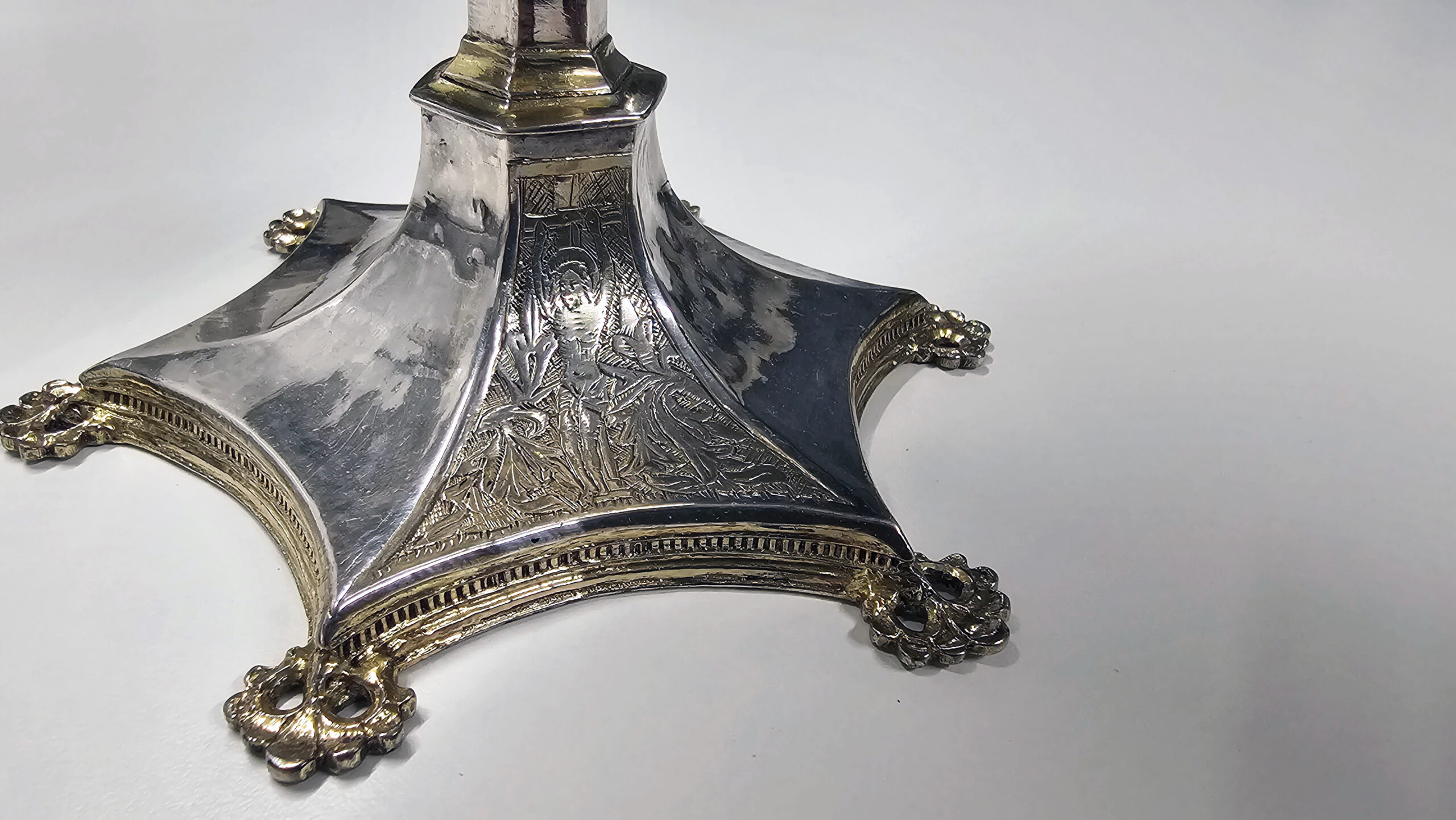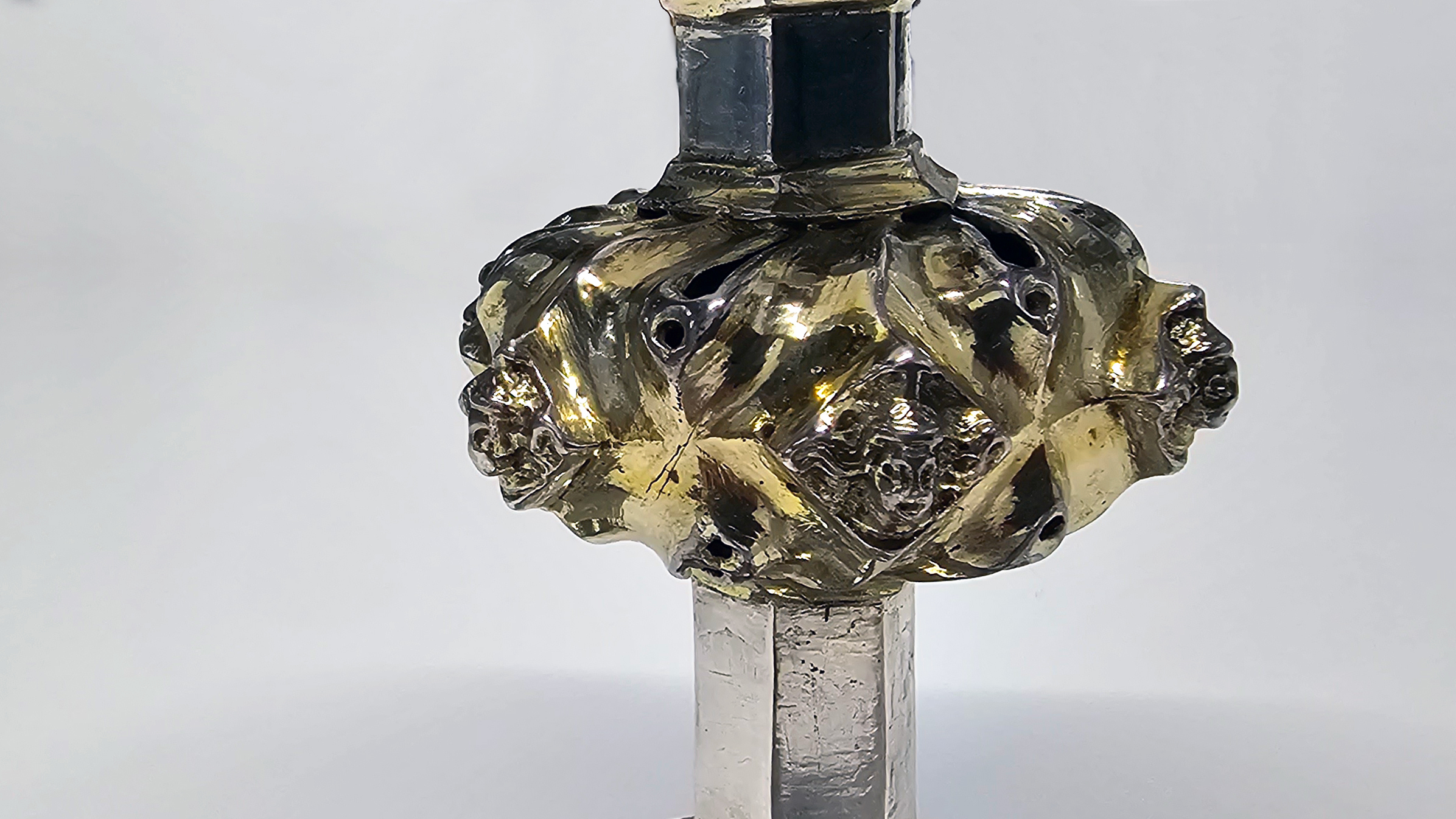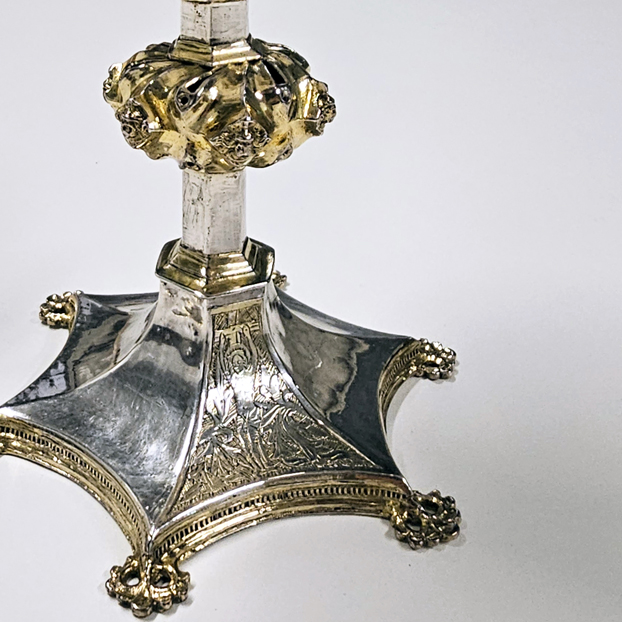
The Coombe Keynes Chalice
The church’s finest treasure was the Coombe Keynes chalice, one of less than a hundred medieval chalices known to exist in England today. The chalice dates from about 1500 and is of silver, parcel gilt.
It was in use at church service up until the 1920s. In the later years of its life, the Dorset Daily Echo recorded that the chalice was carefully hidden away on weekdays by Mrs Annie Cobb in her cottage in the centre of the village. She would bring it out it to show curious visitors, but only those who could produce a note signed by the vicar (see newspaper article at the bottom of this page).
In 1930 it was sent to the V&A museum in London for safe keeping and it remained in their collections until the redevelopment of the Dorset County Museum in Dorchester in 2021. It can now be seen on permanent display in the Medieval Section of ‘The People’s Dorset’ exhibition. A reproduction of the original chalice is still in use today at the Church of the Holy Rood in Wool.
The chalice is thought to originate from the early 16th century, if not an earlier period. This dating is attributed to the presence of distinctive decorative motifs that were more prevalent prior to the Reformation of 1534. Its form, with a pierced knop (the bulbous swelling on the stem) and hexagonal foot with embellished angles, is typical of chalices made in England during the late 15th century.
This dating fits with speculation that the chalice originally came from Bindon Abbey, and was hidden in Coombe Keynes at the time of its dissolved in 1536.
One face of the base depicts The Crucifixion, showing Jesus between two large branches, on a hatched ground. The hexagonal stem features ogee moulded bands at the junctions between the foot, knop and bowl. The twisted knop is formed of six lobes, featuring small openings and terminating in what appear to be crowned angel heads.
Historical References
Extract from ‘The church plate of the county of Dorset. With extracts from the returns of church goods by the Dorset commissioners of Edward VI. 1552′ by James Edward Nightingale, 1889:
Coombe Keynes. — The Chalice here is of pre-Reformation date. It is a beautiful example, quite perfect, and exceedingly well preserved, as will be seen by the illustration. The dimensions are — Height, 6 inches ; diameter of bowl, 4in. ; depth, 2in. ; narrowest part of the mullet-shaped base, 3 in. ; widest part to the points of the knops, 5 fin. The bowl is broad and conical ; the somewhat slender stem is hexagonal and quite plain, with ogee-moulded bands at the junctions. The knot is full-sized, having six lobes spirally twisted with traceried openings, terminating in angels’ heads crowned. It has a mullet-shaped foot with plain broad spread and a vertically reeded moulding. The points terminate with an elegant knop in the shape of a floriated Lombardic M. In the front compartment of the base is the usual crucifix between two flowering branches on a hatched ground. The parts gilt are the interior and outer lip of the bowl, the knot, the Crucifixion, also the mouldings of the stem, the base, and the knops. No hall marks are found, but the date, compared with other examples, is about 1500, perhaps earlier, certainly not much later. The weight is just 10 oz. This is, no doubt, the same chalice found by the Commissioners of Edward VI. at their visitation in 1552, and left for the future use of the parish. It is merely described in their inventory as “One chalice of silver.” There is a tradition in the parish of Coombe Keynes that this chalice was discovered at some unknown period buried in the chancel of the Church.
Extract from ‘The Heart of Wessex’ by Sidney Heath, 1910:
Coombe Keynes is situated a mile or so to the south of Wool, its chief claim to notice being the singularly beautiful pre-Reformation chalice preserved within the church, a building that was extensively restored in 1860. The chalice is one of three pieces of pre-Reformation church plate that now remain in the county, although out of some three hundred parishes over one hundred have retained their Elizabethan chalices, while seventy possess Communion plate of the seventeenth century. The Coombe Keynes chalice is in excellent condition, and is surpassed in beauty only by the very similar but slightly earlier example at Wylye, in Wiltshire. Its height is 6 3/8 inches; diameter of bowl, 4 inches; depth, 2 inches; narrowest part of base, 33/8 inches; widest part, 5¼ inches. The bowl is broad and conical; the slender stem hexagonal and quite plain, with ogee moulded bands at the junctions. The knob is full sized, having six lobes spirally twisted with traceried openings, terminating in angels’ heads, crowned. The date is about 1500, if not somewhat earlier. The two other examples of pre-Reformation plate in Dorset are a paten at Buckhorn Weston, and a chalice at Sturminster Marshall.
Dorset Daily Echo – 1st June 1935, reproduced from Alan Brown’s book The Changing Face of Wool (A. G. Brown, 1999) p250. Alan’s Great Aunt Annie is the Mrs Cobb mentioned in the article below
The picture shows Mini Nod Cottage, in the centre of the village, flanked by Odd Nod to the left and Cuckoo Nod to the right. The large oak tree, planted in celebration of George VI’s coronation in 1937 in the triangle of grass in the centre, is conspicuously absent.
